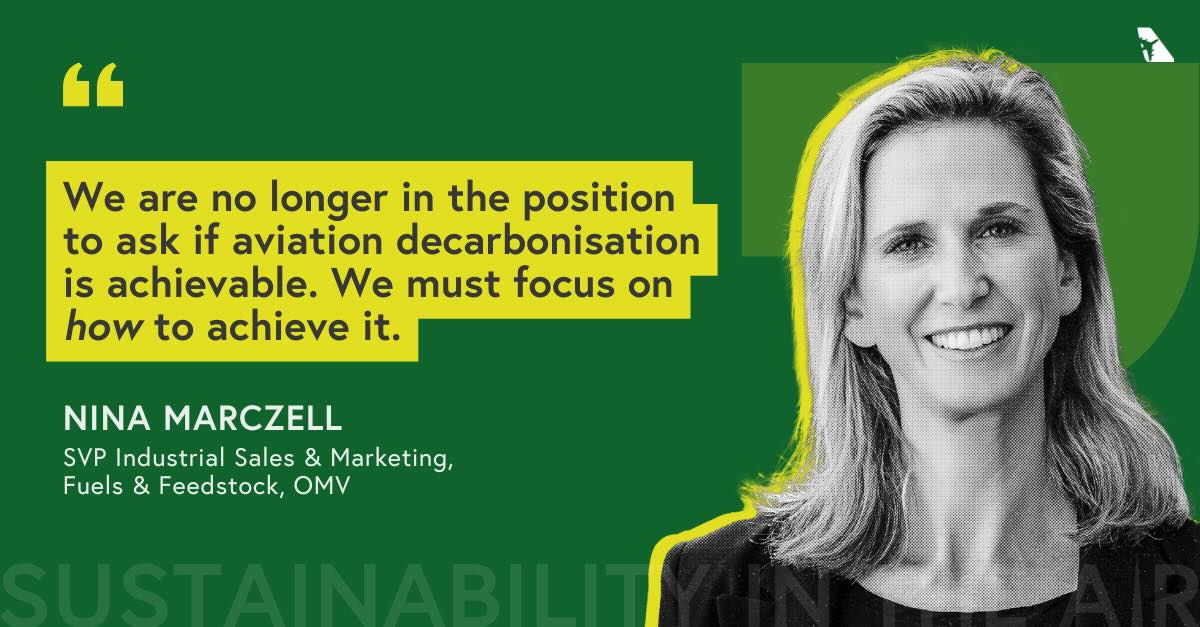In this episode of our 'Sustainability in the Air' podcast, Nina Marczell, Senior Vice President of Industrial Sales & Marketing for Fuels & Feedstock at OMV, speaks with SimpliFlying CEO Shashank Nigam about how the integrated energy company is leading Europe's sustainable aviation fuel (SAF) development from early production to commercial scale.
Drawing from her experience scaling OMV's SAF operations across 17 European airports, Marczell reveals how the company chose to start production well ahead of EU mandates whilst competitors remained hesitant. OMV offers a pragmatic yet ambitious approach to aviation's decarbonisation challenge, treating SAF as a fundamentally different premium product rather than pursuing cost parity with conventional jet fuel.
Here are the key highlights of the conversation:
OMV's early-mover advantage: Starting SAF production ahead of mandates (4:45)
Building Europe's first integrated SAF facility in Romania (11:06)
Strategic partnerships with Airbus and Microsoft (17:30)
The challenges of EU RefuelEU mandate implementation (25:17)
Treating SAF as a premium product, not a commodity (28:44)
Scaling to 1.5 million tonnes of renewable fuels by 2030 (32:15)
Rapid Fire! (36:05)
Keep reading for a detailed overview of the episode.
Why OMV's early-mover strategy matters for scaling sustainable aviation fuel
The SAF industry faces a classic chicken-and-egg problem: producers need demand certainty to justify billion-euro investments, whilst airlines need supply guarantees to plan their decarbonisation strategies. OMV's decision to start producing SAF in 2022, well ahead of EU mandates, demonstrates how early commitment can break this deadlock and create the market foundations necessary for large-scale deployment.
OMV's approach reflects a fundamental understanding that waiting for perfect market conditions often means missing the opportunity to shape them. By beginning with 2,000 tonnes of SAF through co-processing at their Schwechat refinery in Austria and scaling up to 4,000 tonnes, OMV established crucial proof points for both the industry and early airline partners, including Ryanair, Air France-KLM, and Austrian Airlines.
The company's motivation extends beyond immediate commercial returns to strategic positioning within the broader energy transition. As Marczell explains, OMV has identified three "lighthouse projects" as part of their net zero commitment: geothermal energy, re-oil technology for plastic recycling, and SAF. This portfolio approach allows the company to diversify its decarbonisation investments whilst building expertise across multiple energy transition technologies.
Five ways OMV is reshaping the sustainable aviation fuel landscape
1. Integrated production approach with green hydrogen
OMV's upcoming facility at the Petrobras refinery in Romania represents a significant departure from traditional fuel production models. The 250,000-tonne annual capacity plant for SAF and renewable diesel integrates two green hydrogen plants, enhancing both economics and environmental performance.
Marczell explains the strategic rationale: "Green hydrogen is playing two roles here. On the one hand, of course, it's a molecule that is an essential feedstock for fuels and chemicals. So, if we have green hydrogen available, it will help the transition to low-carbon fuels and chemicals. The other part is why we are investing in these plants ourselves is that it is for us a route to decarbonise our own facilities."
This integrated approach addresses two critical challenges simultaneously: securing essential feedstock for SAF production whilst decarbonising existing refinery operations to meet tightening EU climate regulations.
The company has already commissioned a 10-megawatt electrolyser in Austria – the biggest currently running in Austria – and is building a 140-megawatt capacity project, demonstrating serious commitment to the technology.
2. Strategic partnerships beyond traditional supplier relationships
Rather than focusing only on selling fuel, OMV has expanded its collaboration with Airbus far beyond conventional fuel supply agreements to encompass feedstock development, regulatory advocacy, and market structure innovation. This partnership addresses three critical areas that could accelerate SAF adoption across the industry.
The collaboration focuses on expanding voluntary access to SAF through book-and-claim systems, enabling helicopter companies, corporate jet operators, and airlines at smaller airports to participate in the sustainable fuel ecosystem.
As Marczell notes: "We are looking into the solution of a book-and-claim system for driving SAF adoption beyond the mandate. We see this as a key building block to really unlock significant growth."
The partnership also tackles feedstock constraints by accelerating testing and approval processes for new sustainable materials. With used cooking oil supplies limited globally, particularly in Europe, developing alternative feedstocks becomes crucial for scaling production. The combined expertise of a fuel producer and aircraft manufacturer can potentially streamline certification processes that currently create bottlenecks.
3. Innovative corporate SAF programmes
A different approach emerges through OMV’s partnership with Microsoft. Instead of conventional carbon offsetting, the SAF Business solutions programme decouples environmental benefits from physical fuel delivery, enabling companies to reduce Scope 3 emissions exactly where they occur rather than through separate offsetting projects.
Marczell explains the key difference: "The difference between regular carbon offsetting methods is that it's not the way that CO2 is emitted and later you compensate with external or other projects, but actually you have the choice, you have the opportunity to cut the emissions where they are happening."
This model addresses a fundamental challenge in corporate sustainability reporting, where traditional offsetting has faced increasing scrutiny over additionality and measurement accuracy. By directly funding SAF production that reduces actual aviation emissions, companies can make more credible claims about their environmental impact whilst supporting market development.
4. Treating SAF as a premium product
Marczell's perspective on SAF pricing represents a significant departure from industry conventional wisdom. Rather than viewing cost parity with conventional jet fuel as the ultimate goal, she argues for treating SAF as a fundamentally different product with distinct value attributes that justify premium pricing.
"Although chemically, they are almost identical, SAF, regular Jet A1, they are completely different products," she explains. "SAF, in comparison with the regular jet fuel, comes with the attribute to enable flying without having a negative impact on our planet. And this value comes with a different price."
This approach recognises that SAF production requires substantial capital investments, advanced feedstocks, and complex certification processes that create inherently different cost structures. Pursuing artificial cost parity could undermine the investment case for scaling production whilst failing to reflect the genuine environmental value that SAF provides.
5. Addressing regulatory implementation challenges
OMV's experience with the RefuelEU mandate reveals critical implementation challenges that could affect the entire industry's transition timeline. Marczell identifies the steep jumps in mandate requirements as challenging for both producers and airlines, creating supply-demand imbalances rather than supporting steady market development.
"We would actually wish from a producer perspective, and I believe also from an airline perspective, for more gradual increases in the mandate," she notes. "If you go from 2% to 6%, further up to 20%, then you will always be too early or too late, you will have a long market, a short market."
This insight highlights how well-intentioned regulations can inadvertently create market volatility that discourages the very investments they aim to support. OMV's perspective suggests that policymakers might achieve better outcomes through more gradual, predictable increases that allow supply chains to scale systematically.
The company's target of producing up to 1.5 million tonnes of renewable fuels annually by 2030 positions OMV as Southeast Europe's first major sustainable fuels producer. This ambitious goal reflects both the company's confidence in market development and its strategic commitment to the lighthouse project approach that could define the future of European aviation fuel supply.
Get our new book
Our new book, Sustainability in the Air: Volume Two, is now available for purchase on Amazon. Learn more about the startups, strategists, and sceptics working to close the gap between growth and green ambition.
‘Sustainability in the Air’ is the world’s leading podcast dedicated to sustainable aviation. Through in-depth conversations with top aviation leaders, we break through the clutter and provide a clear roadmap for a net-zero future.












